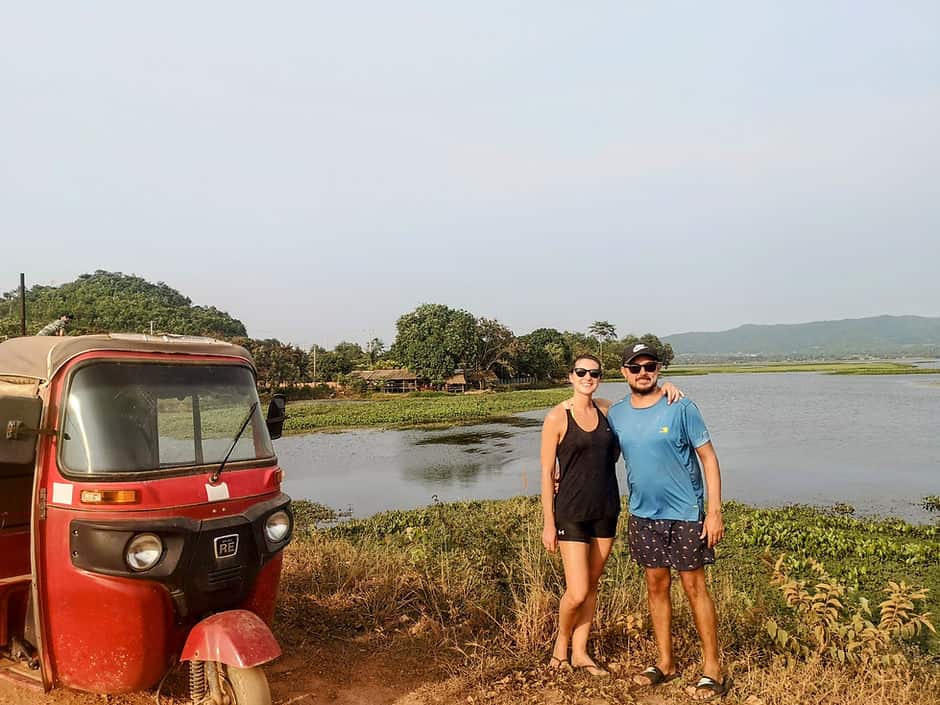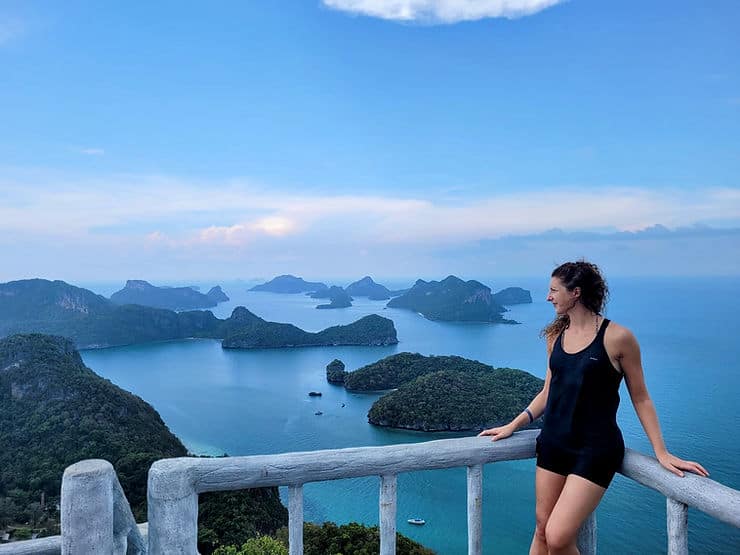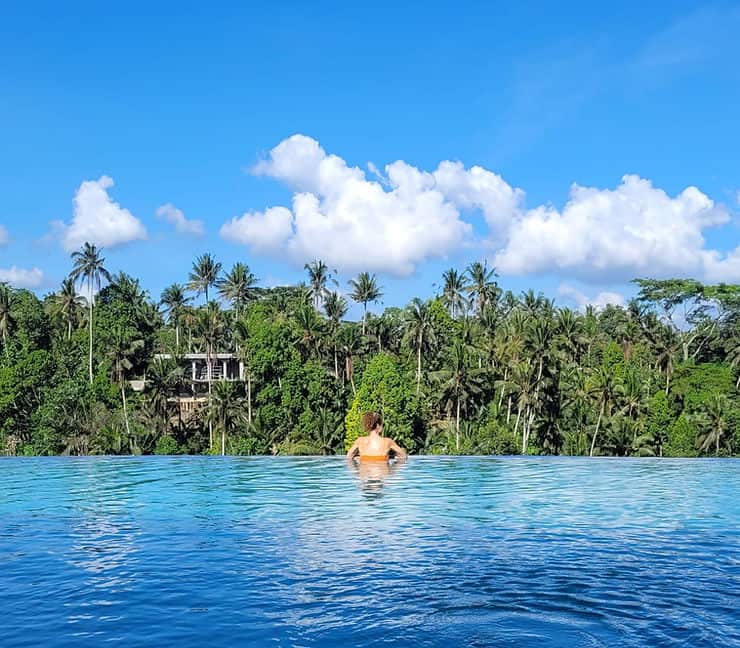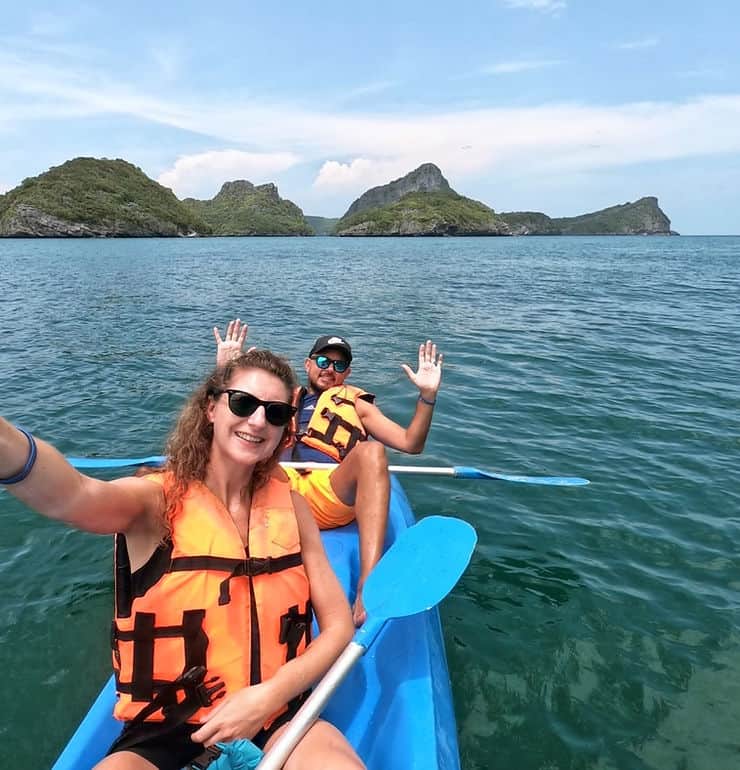
This post may contain affiliate links. I will receive a small commission if you use these links.
Want to go backpacking in Southeast Asia? Try out vanlife in Australia? Or travel around Europe? Planning for full time travel can be daunting, most of all because of the cost. Knowing where and how to start preparing your travel budget can feel overwhelming. That’s why I’ve put together this practical step by step guide for how to budget for full time travel.
Table of Contents
How to budget for full time travel - A step by step guide
This post will guide you through step by step instructions of how to set your travel budget. You can also download my handy Travel Budget Spreadsheet template and simply populate it with your numbers. An easy, simple way to plan your travel budget for your dream trip!
As well as guiding you through completing your own Travel Budget Spreadsheet, I’ll also cover key things you need to think about when budgeting for full time travel.
So, let’s go…!
How can I afford to travel full time?
Before I jump into how to budget for full time travel, I wanted to answer this as it’s a question I get asked a lot – ‘how can you afford to travel full time?!’ Some people we’ve met have even jokingly asked if we’re rich! (Ha! I wish!)
At the time of writing this post, I’ve been travelling full time with my husband for just over a year. We set off in September 2021, spending 3 months in Europe, driving through the beautiful landscapes of Germany’s Black Forest, visiting the Matterhorn in Switzerland and enjoying life on the French Riviera. After a short stop back at home in the UK to spend Christmas with our families, we flew to Thailand in January 2022 and ended up loving it so much, we stayed there for 3 months. Following that, we visited Cambodia, spent a month in Vietnam, had 5 days in Singapore, then continued onto Malaysia and Bali before arriving in Australia, where we are currently travelling around in a van for 3 months. After Australia we fly to New Zealand, where we’ll be enjoying van life again for another 2 months.
Neither of us work whilst we are travelling (although we could both work remotely online if we chose to), so, you’re probably wondering how we afford to travel full time?
Well, the reality is that we spent quite a few years saving really hard for our travels. We consciously decided that we didn’t want to have to work whilst we were taking this time out to travel, so we knew we needed a plan and that involved a lot of saving! We made a rough itinerary of where we wanted to travel and how long we wanted to spend in each place. After that, we then set ourselves a travel budget and started saving! There really is no magic trick I’m afraid, but if you really want something and you are determined to work hard and focus on the end goal, then you can make it happen.
Check out my super simple, but effective tips for how to save for full time travel.

How to create your travel budget - how much money do you need for full time travel?
It’s easy to get carried away dreaming of lying on the sandy beaches of Phuket, in Thailand or visiting elephants in Sri Lanka, but before that becomes a reality, you need to plan your travel budget.
Without knowing how much things cost and how much money you will actually need to travel, you’ll run out of money very quickly. No-one wants to have to cut their trip short because they don’t have any money left!
How much money you will need to travel full time will be different for everyone as it is dependant on a number of things:
- Destination (the place or places you want to travel to)
- Duration (how long you hope to spend in each place)
- Your style of travel (the standard of accommodation, transport, food and drink you are happy with)
- What activities you plan to do (if you have any bucket list activities you want to tick off such as a helicopter ride over the Grand Canyon or snorkel in the Whitsundays, these things will evidently cost more).
The next 9 steps will guide you through how to create your travel budget. This includes not only setting your budget for whilst you are travelling, but also your pre-departure budget, emergency travel funds budget, an ongoing expenses budget and a post travel budget.
That may sound overwhelming, but I promise you it is really quite simple once you get started and hopefully this guide will help you break it down into more manageable chunks.
And to make it even easier for you, I’ve shared my own Travel Budget Spreadsheet as a temple which you can download and use for yourself. It is editable so you can make any changes you might want too.
Creating your Travel Budget in 9 simple steps:
1. Decide on your destination(s)
Deciding where you would like to travel to is one of the first steps you should make when starting to budget for full time travel. Your destination(s) will have a huge impact on how much you need to save. For example, travelling in South East Asia will be far cheaper than in Australia, or in Europe. Once you’ve decided on the destination(s) you would like to visit, make a list of them all.
Personally, I would recommend creating this list in an excel or google docs spreadsheet. This will be your Travel Budget Spreadsheet. If you have several places you want to visit, add each destination into its own cell, one underneath each other. Your Travel Budget Spreadsheet doesn’t need to be fancy, keep it simple.
Task: Make a list of the destinations you would like to visit (in order of preference):
Travel Budget Spreadsheet example:
| Destination | | | |
| Thailand | | | |
| Vietnam | | | |
| Australia | | | |
2. Decide how long you would like to travel for
Some people may advise you to just save as much as you can within ‘x months’ and then figure out how long that can sustain you for. I would recommend having a good idea of how long you would like to travel for first, as this will help you to work out how much money you need to save and how long that will take you. I find that having a figure to work towards also means that you are more likely to keep on track with your saving goal.
If you’re planning to travel to several places, make a note of how long you would like to spend in each place as this will help you to work out your travel budget per destination too.
Task: Go back to your Travel Budget Spreadsheet. In the second and third columns, titled ‘Duration’ in both days and weeks, write how long you would ideally like to spend in each place. At the bottom of the Duration column, add up the number of days / weeks / months to get your total.
Travel Budget Spreadsheet example:
| Destination | Duration (days) | Duration (weeks) | |
| Thailand | 84 | 12 | |
| Vietnam | 28 | 4 | |
| Australia | 84 | 12 | |
| | 196 | 28 | |
3. Research the average costs in each destination
How will you know how much to save if you don’t know how much things cost? Do some research into things like accommodation, transport and the price of meals and drinks. Read blogs, watch YouTube videos but also do some research yourself on sites such as booking.com to see how much accommodation is on average, or on sites like Viator to see how much tours and activities might be.
Tip: It is important when looking into the cost of transport, flights, accommodation and van or car hire to input dates at the same time of year you are planning to travel to that destination. For example, the peak season in Thailand is December – February. During these months, the cost of accommodation and flights will be higher than if you visited during the rainy season July – September.
Once you have done your research, make a note of how much you think you might need per day in that destination. Don’t worry about getting this exactly right. Without actually being in the country, it is hard to know the exact costs of things, so this is more of an educated guesstimate, but an estimated cost based on research is far closer to being correct than if you plucked a figure out of the air!
Remember that your daily cost will be different than someone else’s. Your daily cost will depend on things like the standard of accommodation you are happy with, how often you like to party, what activities you want to do and what kind of places you eat at. Make sure you remember that, especially when reading blogs, or instagram posts or watching YouTube vlogs.
Task: On your destinations list, add a fourth column with your average daily spend for each destination. Note that each destination will have slightly different average daily spends, based on how expensive things are in that country or city.
Travel Budget Spreadsheet example:
| Destination | Duration (days) | Duration (weeks) | Average daily spend (per person) |
| Thailand | 84 | 12 | £30 |
| Vietnam | 28 | 4 | £30 |
| Australia | 84 | 12 | £70 |
| | 196 | 28 | |
4. Set your travel budget
Now you know where you want to travel to, how long you would like to travel for, and how much things cost in your chosen destination(s), it’s time to set your travel budget. Go back to your Travel Budget Spreadsheet. You should now have four columns with the information you have collected so far. Add a fifth column – this is where you will calculate the amount of money you need for each destination.
Now you have worked out how much money you need in each destination, add everything up and you will have the total amount of money needed to complete your dream trip.
At this stage, assess whether this figure is manageable and realistic for you. Do you need to make any adjustments?
Travel Budget Spreadsheet example:
| Destination | Duration (days) | Duration (weeks) | Average daily spend (per person) | Total Destination Budget (days x average daily spend pp) |
| Thailand | 84 | 12 | £30 | £2520 |
| Vietnam | 28 | 4 | £30 | £840 |
| Australia | 84 | 12 | £70 | £5880 |
| 196 | 28 | £9240 |
5. Set a pre-departure budget
Planning a budget for full time travel isn’t just about saving for whilst you are on your trip. You also need to factor in any expenses you may need before your trip. These could include things like travel vaccinations, visas, flights, or purchasing travel essentials such as a backpack, packing cubes, reusable water bottles, etc. You might need to buy a supply of medication or contact lenses. Make a note of everything you need to spend money on in order to prepare yourself for full time travel and add this to your Travel Budget Spreadsheet.
6. Create an Emergency travel fund
No-one wants anything bad to happen whilst you are travelling, but unexpected things can occur. You might need to book a flight to get out of a country quickly in the instance of adverse weather, or you might have an accident and need hospital treatment and your insurance company doesn’t pay out upfront. Always make sure that you have an emergency travel fund and DON’T spend it – unless it really is an emergency! (It is also wise to have a couple of credit cards to fall back on in the case of an emergency. This should be in addition to your emergency travel fund, not instead of!) Add the amount you are planning to set aside for emergencies in your Travel Budget Spreadsheet – and keep this money separate to your travel pot!
7. Budget for any ongoing expenses
Ongoing expenses include anything that you will need to continue to pay for, even whilst you are travelling. For example, we have a storage unit full of everything we own, which we pay a monthly direct debit for. I calculated how much money we would need to save in order to continually pay for our storage unit during the time we were away (plus extra months in case we extended our travels!).
Other ongoing expenses may include mortgage payments, insurance policies, an outstanding phone contract which you need to pay off, a Netflix subscription etc. No matter how small, add all ongoing expenses to your Travel Budget Spreadsheet. Make sure you calculate how much money you will need in order to continuously cover these expenses for the duration of your trip (or however long you need to keep making the payments for). The money needed for ongoing expenses should be in a completely separate bank account to your travel budget pot. This ensures that you always have money to cover these direct debits.
Task: Add all ongoing expenses to your Travel Budget Spreadsheet and account for these when saving
8. Plan for a ‘coming home’, post-travels budget
I know, you’ve not even started your travels and I’m talking about coming home! This seems super boring, but the last thing you want after your travels are over is to get home to absolutely nothing. Plan to put a little aside so that you have some money when you come home to help set yourself up again. For example, you might need to put some money aside to buy a new car, or for the first couple of month’s deposit in a rental unit.
Task: Write down things you would need to pay for upon your return and add an estimated cost for this to your Travel Budget Spreadsheet. (I would also make sure that you keep this money in a separate bank account to your travel pot, so that you aren’t tempted to dip into it)!
9. Decide on a date to start travelling
Now you know how much money you need to save for your trip, plan how long that will take you to save. Set up a direct debit into your savings account, or open up a specific ‘travel account’ and transfer money into there each week, fortnight or month.
Having a goal of how much you need to save and a date to work towards will make it easier for you to focus on saving for your travels. Be realistic with your timeline. If you want to set off sooner, make a plan for how this could be possible for you.
My husband and I chose not to work. We made a conscious decision to take some time out, away from our busy careers and simply enjoy travelling. We planned for this from the beginning and we were really strict with ourselves, sticking to our plan to save.
Of course, this may not suit everyone and if you don’t want to wait until you have saved enough, or perhaps you want to be able to travel with no end date, then that’s great! But make sure that you plan for that too. Could you save 50% of what you need initially, then work remotely to earn more as you go? There are lots of ways to earn money online whilst you’re travelling. Or, depending on the country you are in, you could also get a working visa to help top up your travel pot.
You could also consider joining a Workaway program where you work for a few hours a day in return for free accommodation. Or how about being a house sitter or dog sitter, if you don’t mind staying in one place for a few weeks? These are all great ways to get free accommodation which is a great help to your budget.

How to keep your travel budget on track (and not overspend!)
You’ve spent many months saving hard and finally the time has come for you to set off on your travels! (YAY!) Whilst it’s easy to get swept up in the excitement of travelling (of course you should be excited, travel is the best!), it is important that you keep a track of your spending. It sounds boring, but trust me, you don’t want to find out that you’ve spent all your hard earned money too quickly and now have to cut your trip short.
So, to make sure that doesn’t happen, here’s my 3 top tips for keeping track of your travel budget whilst travelling:
1. Track your daily travel spend
Don’t worry, I won’t be suggesting that you fill in a spreadsheet everyday (although you can if you want to!). I use the Travel Spend app religiously, in fact I’m a little bit obsessed with it! It is without a doubt my favourite travel app. There’s a paid version where you can have multiple trips displaying at once, and add your own custom categories, but to be honest, I’ve been fine with just using the free version for the past year.
I prefer to have a new entry on the travel spend app by country, as I have different daily budgets for each country. To get started, simply add the name of the country you are starting in, add the total budget you have set yourself for that country, as well as the beginning and end dates you are there. The app will then automatically calculate what your daily spend should be based on your total budget and number of days – this should match the daily budget figure you have on your Travel Budget Spreadsheet.
Each time I buy something, I enter it onto the app, even if it’s just a single bottle of water. The app will total how much you have spent that day, as well as showing you how much of your total budget you have remaining.
Try not to get too caught up on what you have spent each day, as some days you will go over budget and some days you will go under. You need to focus on the ‘daily average spend’, and as long as this matches (or is close to) the figure you have budgeted for, you are on track.
2. Record your total spend per location
Once your time is up in a country or destination, record your total spend in your Travel Budget Spreadsheet. This is a good way to keep track of your actual spend and you can also compare it against the budget you had forecast for that destination to see if you were significantly over or under budget.
Noticing any discrepancies in this way will allow you to make any adjustments you might need to the rest of your budget. For example, if you are under budget, you know that you can afford to have a couple of treats in your next destination. But if you have gone way over budget, you need to look at where you can claw back some money, or decide to earn some extra money as you travel.
If you are travelling to several destinations, and are using the free version of the Travel Spend app, you will need to delete your current country in the app in order to record your spend in a new country. So, just make sure that you have inputted your total spend into your Travel Budget Spreadsheet before deleting that country in the app!
3. Make any adjustments needed to your ongoing expenses budget
If any of the regular payments you are making as ‘ongoing expenses’ change, you will need to adjust this in your spreadsheet and make sure that you have enough in your ‘ongoing expenses’ pot to cover any additional costs or price rises on things like storage unit hire, insurance or subscriptions.

So there you have it, my step by step guide to creating and managing your travel budget, along with top tips for keeping your spending on track!
Creating a travel budget doesn’t need to be complicated, the hardest part is saving! Even then, if you are determined to travel and you’re focused on the end goal, then the saving part won’t feel too much of a chore either. Make sure you check out my 12 simple tips to save for full time travel.


